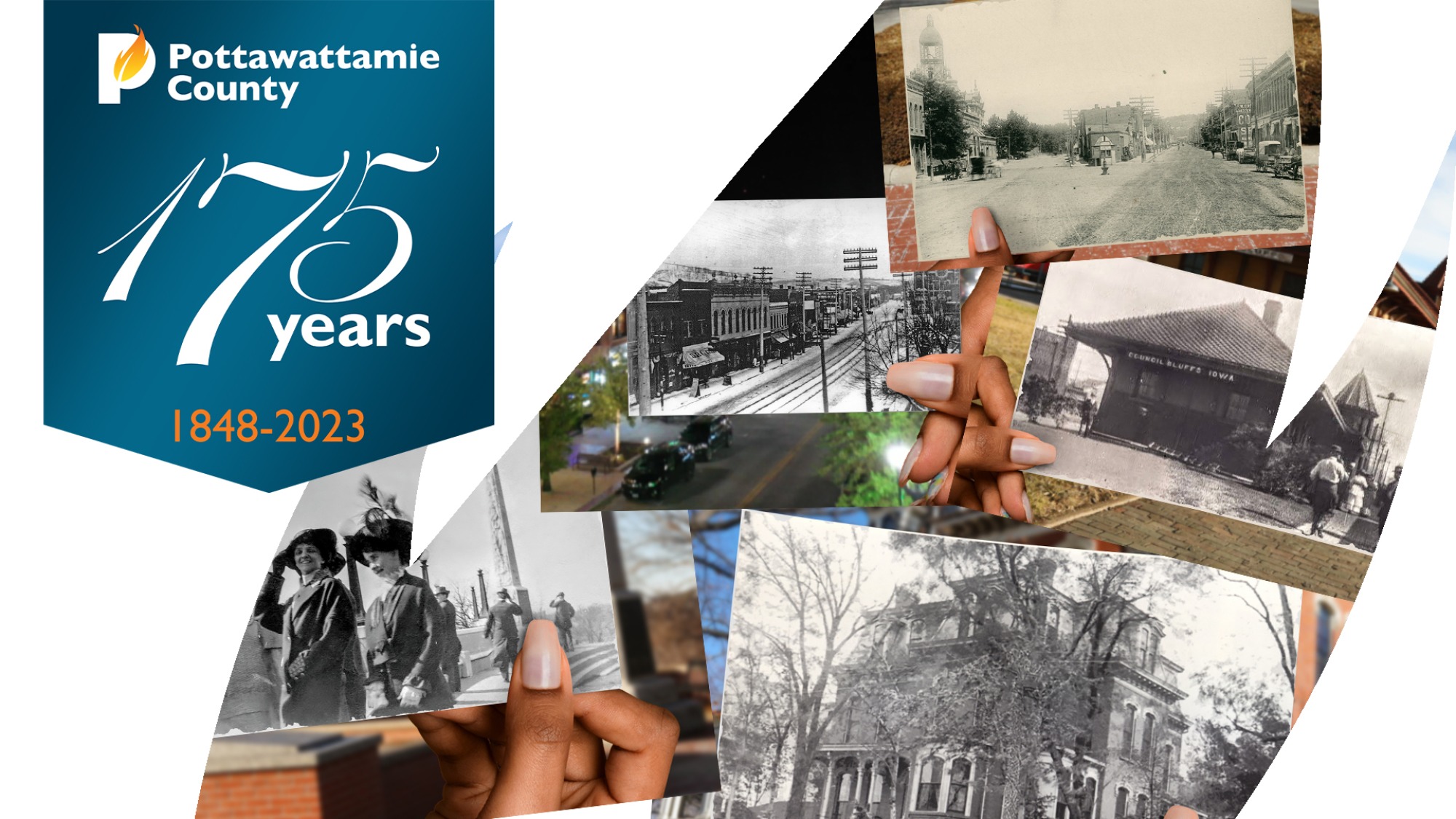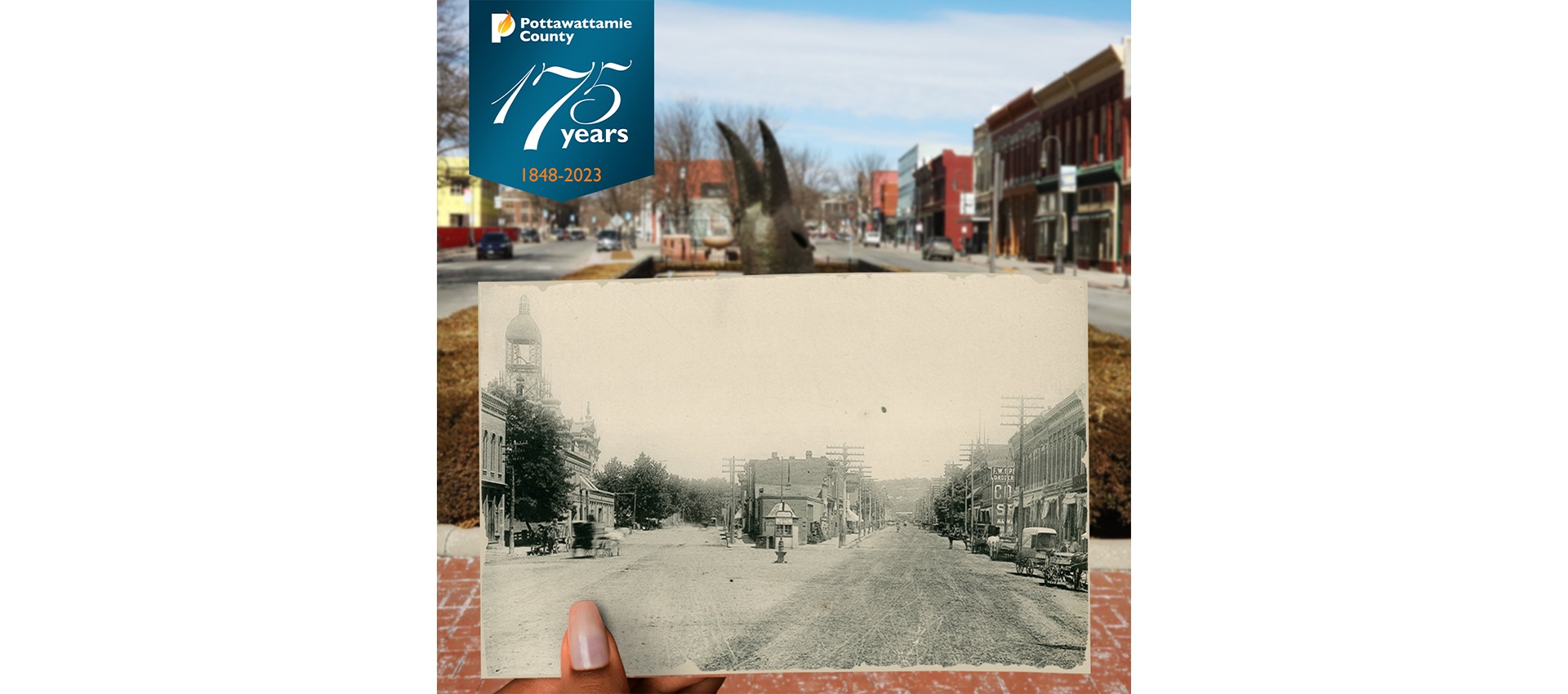These popular topics are heating up. Explore today's most viewed pages.

Posted June 7, 2024
Posted by Public Relations and Animal Control
Pottawattamie County, Iowa, was a part of the Pottawattamie Purchase of 1847. While first established on February 24, 1847, Pottawattamie County was officially organized on September 21, 1848.
From September 2023 to September 2024, Pottawattamie County will celebrate its 175th year as an organized county by highlighting locations with historical significance.
We thank the Historical Society of Pottawattamie County for helping preserve our history, including photos like those presented in the images below.
The Pottawattamie County Sub Courthouse, is a historic building located in Avoca. It has been listed on the National Register of Historic Places since 1981.
Because Pottawattamie County is wide geographically, and the county seat in Council Bluffs is located at its western edge, this sub courthouse was constructed in the eastern portion of the county. It is Iowa's only branch county courthouse.
Built in 1885 and refurbished in 1998, the building is simple, compact, and functional. Today, some County business continues to take place at the location.
Featuring a 200-year-old bench and canopy from an old English castle, the courthouse is available for tours by appointment.

The former Council Bluffs Public Library building has been listed on the National Register of Historic Places since 1999.
The public library in Council Bluffs had its beginnings in 1866, when a subscription library was established for males over the age of 12. The Council Bluffs Library Association was formed in 1878. The Free Public Library was created in 1882, and it operated out of rented space.
W. S. Baird, a library trustee, contacted the Carnegie Foundation who agreed to fund a new building at $70,000 if the city agreed to provide a site and institute an annual tax of $7,000 to operate the facility. The grant was awarded on January 6, 1903, and the new building was dedicated on September 12, 1905. It was designed by the Chicago architectural firm of Patton & Miller in the Beaux-Arts-style. It was the largest Carnegie library built in the state.
The present Council Bluffs Public Library was completed in 1998. The Carnegie-funded building has been converted into the Union Pacific Railroad Museum. The city retains ownership of the old building, the Union Pacific Railroad pays for the operating costs, and the library maintains the collection.
Plan a visit to the U.P. Museum.

The Bennett Building, also known as the Ervin Building, is a historic building in downtown Council Bluffs. It has been listed on the National Register of Historic Places since 2001.
The previous building to occupy this property was a Woolworth's that was destroyed in a fire in 1922. The Bennett Building Corporation was formed in 1923 to build an office building that was designed to attract medical professionals.
The first floor houses storefronts and the entrance lobby for the offices above. Floors two through seven contained professional offices, with many of them occupied by physicians and dentists. Many of Council Bluffs' women doctors had their practices here.
For doctors and dentists, the building was equipped with gas and compressed air, and each suite was provided with a lavatory with hot and cold water. All the rooms were designed with generous proportions, so that they could be easily sub-divided or reorganized. For the patients, two of the latest high-speed elevators were installed to handle the expected traffic and toilets were installed on each floor, alternating men’s and women's. Marble floors and baseboards in the corridors gave the building a rich appearance. Today, the Bennett Building serves as an apartment building.

State Savings Bank, also known as the Old Savings Bank, is a historic building located in Council Bluffs. It has been listed on the National Register of Historic Places since 1984.
The bank was established in 1889 and was originally located across the street. Planning for this building began in 1941 with the organization of the State Investment Company, which would build and own the building.
The design of the structure is a late example of Art Deco, and it's the only building in Council Bluffs that exhibits this style. Its primary decorative feature is an inscribed harvest motif on the east and west elevations that are mirror images of each other. The motif features a male holding a wagon wheel and a scythe, with sheaves of wheat and a dog.
The bank changed its name to State Bank & Trust in 1967 and continued to operate from here until 1978. The building sat empty for five years when it was renovated for use by State Investment Company and other offices. The building now houses a branch office of First Interstate BancSystem.

Prior to merging with the AHST School District, the last classes offered by the Walnut Community School District occurred in May 2016. After 144 years of education, Walnut Community School was closed. The City of Walnut agreed to take possession of the facility and with the help of residents and the Walnut Community Center Foundation, the goal to repurpose the building as a Community Center was realized.
The City of Walnut has a development agreement with Black Sailboat to complete the vision. The overhaul includes turning the 1913 original school building into apartments, transforming the newest portion into an event center that provides revenue for operational expenses, creating a community fitness center, and modifying the 1961 high school building for leasing to businesses and organizations.

The Pioneer Implement Company, also known as the International Harvester Transfer House, is a historic building in Council Bluffs. It has been listed on the National Register of Historic Places since 2008.
Eli Shugart, Ferdinand Weis and F.R. Davis formed Pioneer Implement Company in 1893, and they built the four-story Late Victorian section of the building the same year. This was during a period of growth in the city's "Implement District," which is located to the south of the central business district.
What made this company standout from the others in the district is that it was a locally owned and operated agricultural implement business, rather than one owned by a factory from the east. The company went out of business in 1915 and the building was taken over by International Harvester, which owned the building next door. They added the single-story brick addition to the south in 1927.
When IH closed their Council Bluffs operation in 1964 they were the only farm implement that was still in business in the Implement District. The building was occupied by various businesses after that, including United Parcel Service.
Artspace, Inc. acquired the building in 2008, and thanks to the Iowa West Foundation and other financial partners, the building was converted into useable space for artists. The Harvester Artspace Lofts showcases 36 units of live/work space for creatives and their families along with arts-friendly commercial space.

The Haymarket Commercial Historic District was developed between 1865 and 1930. It is a nationally recognized historic district in Council Bluffs, listed on the National Register of Historic Places in 1985.
"Haymarket" is the forked junction of Main and Pearl Streets where the city's scales were located in the 1890s. The buildings here are among the earliest extant commercial buildings in the city.

The Chicago, Rock Island and Pacific Railroad Passenger Depot opened in 1899 and became a daily stop for the Rocky Mountain Rocket, Midwest Hiawatha, the Arrow, and Corn Belt Rocket before the end of passenger service in 1971.
The depot in Council Bluffs is listed on the National Register of Historic Places and is also known as Rock Island Depot.
Today, the Historical Society of Pottawattamie County operates RailsWest Railroad Museum at the location, illustrating the history of railroads in Council Bluffs.
Plan a visit to RailsWest Railroad Museum.

The Grenville M. Dodge House is a historic house museum in Council Bluffs. This Second Empire mansion, built in 1869, was the home of Grenville M. Dodge (1831-1916), a Union Army general, politician, and a major figure in the development of the railroads across the American West.
The house was declared a National Historic Landmark in 1961, and in 2005 it was included as a contributing property in the Willow-Bluff-3rd Street Historic District.
Plan a visit to the Historic General Dodge House.

The Lincoln–Fairview Historic District was developed between 1846 and 1956. It is a nationally recognized historic district in Council Bluffs, listed on the National Register of Historic Places in 2007.
The Daughters of the American Revolution erected the Lincoln Monument in 1911. It commemorates Abraham Lincoln's visit to the site in 1859, where he viewed and selected the Eastern Terminus of the first transcontinental railroad built in the United States.

The 100 Block of West Broadway Historic District was developed between mid-1850s and 1928. It is a nationally recognized historic district located in Council Bluffs, listed on the National Register of Historic Places since 2002.
At the time of its nomination the district consisted of 30 resources, including 22 contributing buildings, and eight non-contributing buildings. The buildings are one to three stories tall with commercial space on the main floor. While many are vernacular commercial structures, others are the various revival styles of Victorian architecture.
